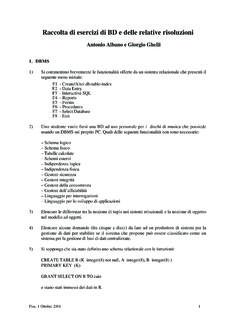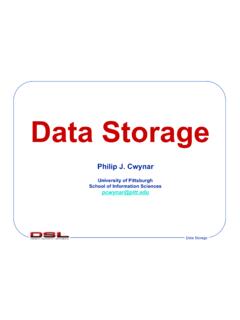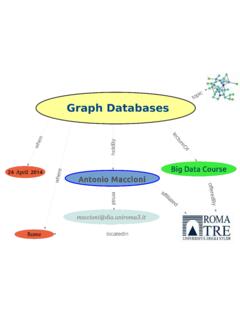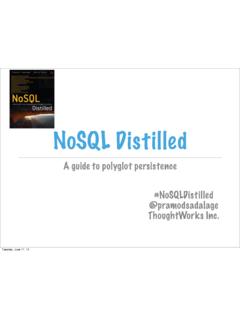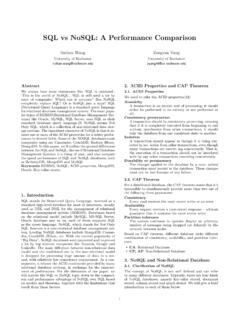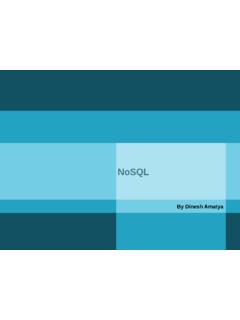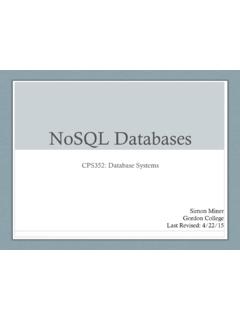Transcription of Big Data and NoSQL - unipi.it
1 big data and NoSQLVery short history of DBMSs The seventies: IMS end of the sixties, built for the Apollo program (today: Version 15) and IDS (then IDMS), hierarchical and network DBMSs, navigational The eighties for twenty years: Relational DBMSs The nineties: client/server computing, three tiers, thin clientsObject Oriented Databased In the nineties, Object Oriented databases were proposed to overcome the impedencemismatch They influenced Relational Databases, and disappearedBig data Mid 2000s, big data : Volume: DBMSs do not scale enough for some applications Velocity: Computational speed Development velocity: DBMS require upfront schema design and data cleaning Variety: Schemas conflict with varietyBigDataplatforms The google stack: Hardware: each Google Modular data Center houses Linux servers with AC and disks GFS: distributed and redundant FS MapReduce BigTable, on top of GFS Hadoop open source HDFS, Hadoop MapReduce HBase SQL on Hadoop: Apache Hive, IBM Jaql, Apache Pig, Cloudera ImpalaNoSQL Giving up something to get something more Giving up: ACID transactions, to gain distribution Upfront schema, to gain Velocity Variety First normal form, to reduce the need for joins Different from NewSQLT ypes of NoSQL systems Key-value stores (Amazon Dynamo, Riak, ) Document databases: XML databases: MarkLogic, eXist JSON databases.
2 CouchDB, Membase, Couchbase MongoDB Sparse table databases: HBase Graph databases: Neo4jNewSQL Column databases In memory databasesNoSQLWhy NoSQL Impedance mismatch Restrictiveschema Integration databases -> application databases Cluster architecture Google BigTable Amazon DynamoNoSQL A set of ill-defined systems that are not RDMBS Usually do not support SQL Are usually Open Source (not always) Often cluster-oriented (not always), hence no ACID Recent (after 2000) Schema free Oriented toward a single application It is more a movement than a technologyAggregate data model NoSQL data models: Aggregate data models: Key-value Document Column family Graph modelAggregate datamodels Key value stores: the database is a collection of <key,value> pairs, where the value is opaque (Dynamo, Riak, Voldemort) Document database: a collection of documents (XML or JSON) that can be searched by content (MarkLogic, MongoDB) Column-family stores: a set of <key, record> pair (BigTable, HBase, Cassandra) Columns are grouped in column families Key-valuestores implementation Implementation model.
3 Key-based distribution of the pairs on a huge farm of inexpensive machines Constant time access Constant time parallel execution on all the pairs Flexible fault-tolerance MapReduceexecution model Amazon Dynamo, Riak, VoldemortGraph databases Set of triples <nodeid, property, nodeid> (FlockDB, Neo4J)Schemalessdatabases Schema first vs. schema later Homogeneous vs. non homogeneousMaterializedviews OLAP applications greatly benefit from materialized views Materialized views can be used to regain the flexibility of the relational modelDistribution Models Sharding: splitting data among nodes according to a key Master-slave replication No update conflict Read resilience Master election P2P replication No single point of failure Sharding+ replicationConsistency Write-write conflicts: avoiding to lose an update Read consistency: Fresh data No intermediate data Session consistency Transactional consistency Writing values that are based on data that is not valid any moreThe CAP Theorem You cannot have all of.
4 Consistency Availability Partition tolerance A trade-off between consistency and latency Relaxing consistency Two writes in the same cart Relaxing durabilityConsistency Quorums: in a P2P system, an operation is successful if it gets a quorum of confirmations The write quorum: W > N/2 The read quorum: R+W > N Version stamps: Counter, GUID, content hash, time-stamp Consistent write after readMap-Reduce Map: maps each object to a set of <key, value> pairs Shuffle: collect all pairs with the same <key> to the same node Reduce: for each set {<k,v1>,..,<k,vn>} produce a result Combine-Reduce: If reduce is associative, all same-key pairs can be combined locally before shufflingMap-Reduce Map: <key1, value1> -> set(<key2,value2>) Combine: <key2,set(value2)> -> <key2,value2> Reduce: <key2,set(value2)> -> <key2,value2> Input of Map and output of Reduce must be put somewhere HDFS Main memory (Spark) Examples OrderLine(Product, Amount, Date): group by productKey-Value Databases Basically, a persistent hash table Sharding+ replication Consistency Single object Riak: for each bucket ( data space): Newest write wins / create siblings Setting read / write quorum Query By key Full store scan (not always provided) Uses.
5 Session information, user profiles, shopping cart data by Databases: MongoDB One instance, many databases, many collections JSON documents with _id field Sharding+ replicationConsistency Master/slave replication Automated failover, server maintenance, disaster recovery, read scaling Master is dynamically re-elected over fail One can specify a write quorum One can specify whether reads can be directed to slavesQuerying CouchDB: query via views (virtual or materialized) MongoDB: Selection, projection, aggregationColumn-family Stores A column-family (similar to a table in relational databases) is a set of <key,record> pairs Records are not necessarily homogeneous Confusing terminology Column: a field such as age:=35 Supercolumn: address:={city:= Pisa.}
6 } Row: a pair key-record (record: set of columns): <johnsmith_001657, {name:= John , age:=35}> Column family: set of related rows Keyspace: set of column familiesConsistency In Cassandra: The DBA fixes the number of replicas for each keyspace the programmer decides the quorum for read and write operations (1, majority, ) Transactions: Atomicity at the row level Possibility to use external transactional librariesQueries (Cassandra) Row retrieval: GETC ustomer[ johnsmith00012 ] Field (column) retrieval: GETC ustomer[ johnsmith00012 ][ age ] After you create an index on age: GETC ustomerWHEREage = 35 Cassandra supports CQL: Select-project (no join) SQLG raph Databases A graph database stores a graph We will talk later about a specific graph model: RDF Example: Neo4 JConsistency Graph databases are usually not shardedand transactional Neo4J supports master-slave replication data can be shardedat the application level with no database support, which is quite hardQuerying: CypherMATCH (me {name:"Giorgio"})RETURN meQuerying: CypherMATCH (expert)-[:WORKED_WITH]->(neodb:Database {name:"Neo4j"})RETURN neodb, expertQuerying: CypherMATCH (me {name:"Giorgio"})MATCH (expert)-[:WORKED_WITH]->(neodb:Database {name:"Neo4j"})MATCH path = shortestPath( (me)-[:FRIEND*.)]
7 5]-(expert) )RETURN neodb, expert, path Querying: CypherMATCH pattern matchesWHERE filtering conditionsRETURN whatto returnORDER BY properties to order bySKIP nodes to skip from the topLIMIT limitresultsPolyglot Persistence Transactional RDBMSs, DSSs and NoSQL systems have different strength and it is naturalto combine all of them However, such a heterogeneous environment can create huge problems of maintenance and securitySources P. J. Sadalage, M Fowler, NoSQL distilled , Addison Wesley



